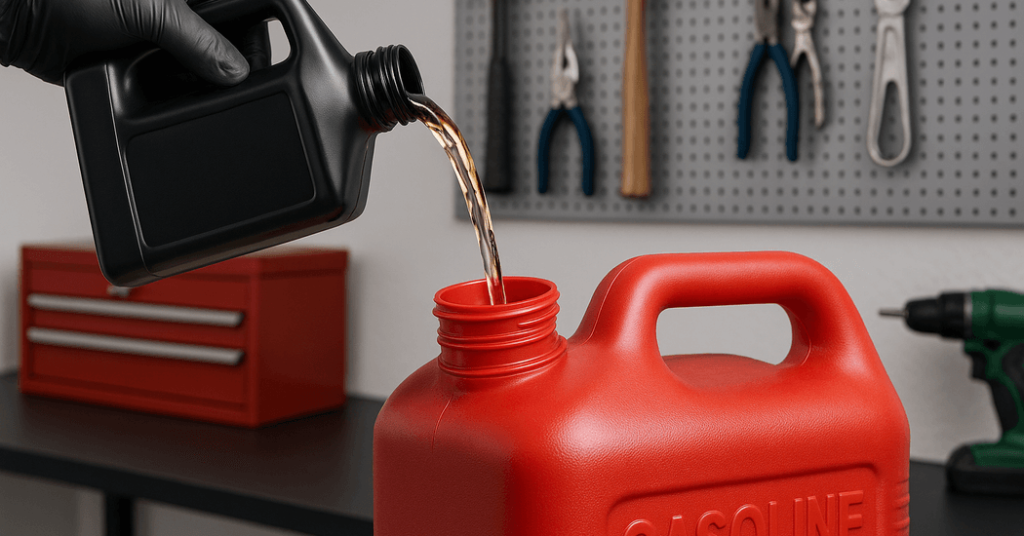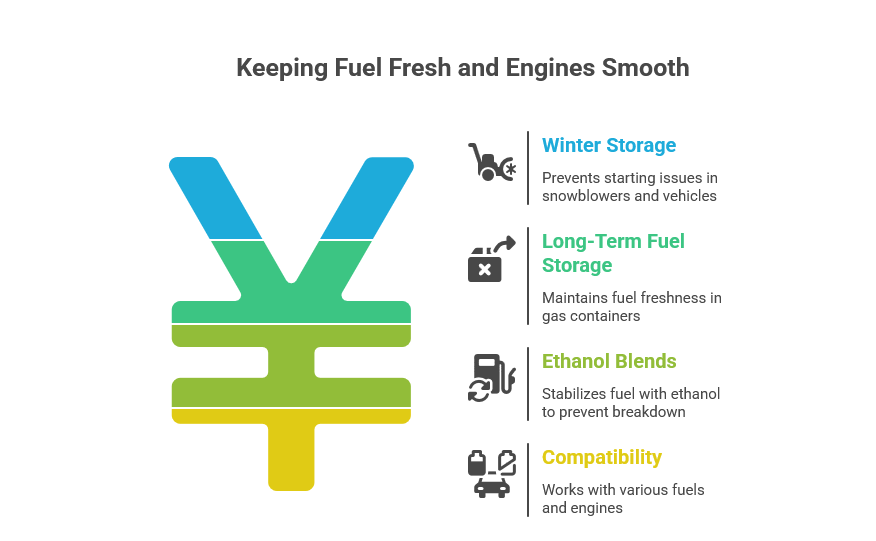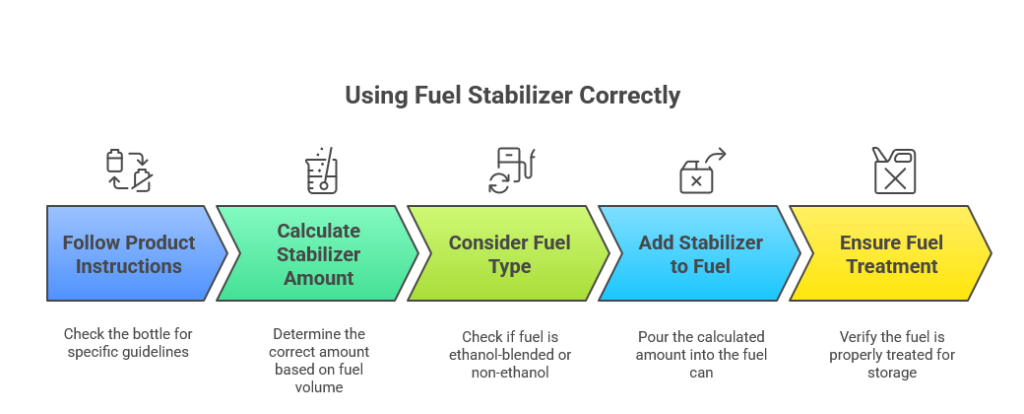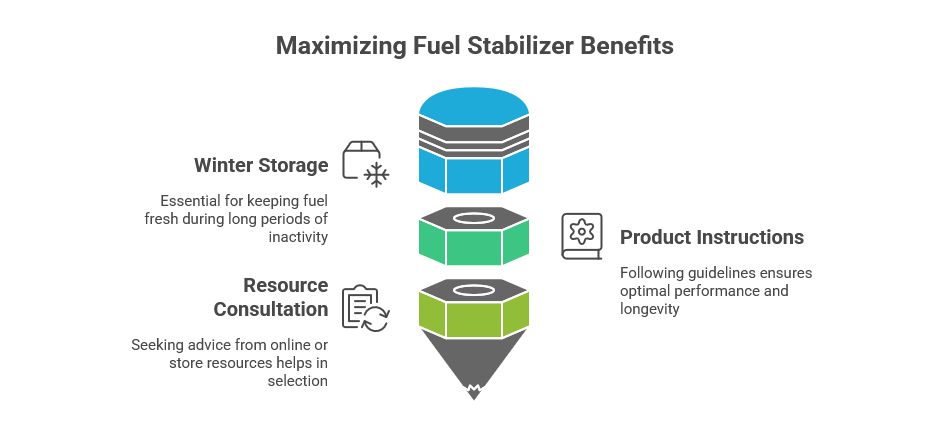This article was updated in August 12, 2025 with new products and information by Mark S. Taylor
If you’ve ever left gas in a can for too long, you know it can go bad fast. Whether you’re storing gas for your lawnmower, generator, or car, learning how to use fuel stabilizer in a gas can is key. I’ve been through the frustration of dealing with bad gas that ruined my equipment, so I want to save you the trouble. In this guide, I’ll show you exactly how to use fuel stabilizer, share tips from my own experience, and highlight the best stabilizers for the job. Let’s get your gas ready for the long haul!

Contents
What Is a Fuel Stabilizer and Why Should You Use It?
A fuel stabilizer helps keep gas fresh for longer. If you’ve ever left fuel in a gas can for a few months, you know it can turn bad. This is where a fuel stabilizer comes in. It stops gasoline from going stale, so it’s ready to use whenever you need it. I’ve used it many times, especially when storing gas for my lawnmower or generator, and it has saved me from headaches.
Fuel stabilizer works by slowing down the breakdown of gas. Without it, the fuel can start to gum up, making it hard to start engines. I’ve had this happen before, but using stabilizer has kept my equipment running smoothly every time.
Understanding Fuel Stabilizers
Fuel stabilizers are easy to use and really effective. Here’s why I recommend them:
- Prevents stale gas: Gas can go bad quickly. A stabilizer keeps it fresh for a much longer time.
- Keeps your fuel shelf life longer: If you don’t use your gas right away, like for a lawnmower over winter, fuel stabilizers keep it fresh and ready to use.
- Protects the fuel system: A stabilizer not only keeps gas fresh, but it also helps protect the fuel pump and fuel lines from gunk and build-up.
Key Benefits of Using Fuel Stabilizers
I’ve learned a lot from using fuel stabilizers over the years. Here are the big benefits:
- Prevents corrosion: Gas that sits for too long can cause rust and damage inside the fuel tank and lines. A stabilizer stops this from happening.
- Easy starts after storage: I’ve used my lawnmower after it’s been in storage all winter, and it started up easily. Fuel stabilizer keeps engines running smoothly, even after months of storage.
- Better performance for small engines: Using stabilizer in my lawnmower and generator helps them run better. The gas stays fresh, and the engines start easily without problems.
Fuel stabilizers are a simple way to make sure your gas stays fresh and your engines run well. They’ve saved me time and money by preventing fuel from going bad. Whether you’re storing gas for a lawnmower, generator, or any other small engine, using a stabilizer is a smart choice. It’s helped me a lot, and I’m sure it will help you too!

When and Why Should You Use Fuel Stabilizers?
If you’ve ever had trouble starting your equipment after storing it for a while, bad gas might be the reason. Fuel stabilizers can solve this problem. Here are the best times to use them:
Ideal Scenarios
- During winter storage for snowblowers and vehicles: I always add stabilizer to my snowblower before I store it for the winter. It keeps the gas fresh so the engine starts up easily when I need it.
- Before long-term storage of fuel in gas containers: When I fill up a gas can for my mower or generator, I make sure to add stabilizer. It keeps the fuel fresh and ready to use later.
- For extended periods with ethanol blends or diesel fuel: Ethanol can cause fuel to break down faster. Using stabilizer in my car or lawnmower helps keep the gas in good shape for longer.
Good News About Fuel Stabilizers
- They work for ethanol-free gasoline and premium fuel: Whether I’m using ethanol-free gasoline or premium fuel, stabilizers work great to keep the gas fresh. It helps with all types of fuel.
- Compatible with small engines, pressure washers, and classic cars: I use stabilizer in my lawnmower, pressure washer, and even in my classic car. It ensures the fuel stays fresh and the engine runs smoothly when I need it.
Fuel stabilizers are an easy way to keep your gas fresh and your equipment running smoothly. I’ve used them for years, and they’ve saved me from a lot of engine trouble. Try using one the next time you store fuel!
How to Add Fuel Stabilizer to a Gas Can
If you’re like me, you’ve probably left fuel sitting in a can for months, only to find it’s gone bad when you need it. The good news is that adding fuel stabilizer to a gas can is an easy way to keep your fuel fresh for much longer. Here’s how I do it, step by step:
1. Choose the Right Amount of Stabilizer
First, check how much fuel you’re storing. You’ll need to add a specific amount of stabilizer based on the gallons of gas in your can. For example, I use one ounce of stabilizer for every gallon of fuel. The stabilizer bottle will tell you the exact amount, so you can follow that for best results.
2. Pour the Stabilizer Into the Gas Can
Next, open your gas can and pour the stabilizer in. It’s as simple as that! I always double-check the amount just to make sure it’s right. No need to overthink it; just add it and move on to the next step.
3. Add Fresh Gas to the Can
After the stabilizer, add fresh fuel to the can. I prefer to use ethanol-free gas, especially for small engines like my lawnmower. But if you’re using regular gas, that’s fine too—just know the stabilizer helps protect it.
4. Seal the Can Tight
Once the stabilizer and fuel are in, seal the gas can tightly. This keeps air and moisture out, which could affect the fuel. I make sure the lid is on securely to avoid any spills or contaminants.
5. Shake to Mix
Now it’s time to shake the can! I give it a good shake for about 20-30 seconds to make sure the stabilizer mixes with the gas. This step ensures everything is blended well, so the stabilizer works its magic.
Tip: I’ve found that shaking the can really helps. It’s an easy step, but it makes a huge difference in making sure the stabilizer mixes evenly.
Adding fuel stabilizer to a gas can is a simple, quick process. It helps keep your fuel fresh for months, so you don’t have to worry about bad gas. I’ve been doing it for years, and it’s saved me a lot of headaches. Try it next time you’re storing gas, and you’ll notice the difference!

How Much Fuel Stabilizer Should You Use?
When adding fuel stabilizer to a gas can, the right amount is key. I remember the first time I used stabilizer for my lawnmower. I wasn’t sure how much to use, but I quickly learned it’s simple once you know the basics. Here’s what I’ve learned about how much fuel stabilizer to add:
Determining the Right Amount
- Follow the Product Instructions: The easiest way is to follow the instructions on the bottle. For STA-BIL or Seafoam, the instructions tell you exactly how much to use for your fuel. I always double-check to make sure I get it right.
- 1 Ounce for 2.5 Gallons of Fuel: Generally, 1 ounce of stabilizer treats 2.5 gallons of fuel. I use this for most of my small engines. So, for a 5-gallon gas can, I’d use 2 ounces. It’s easy math, and it ensures your fuel is treated correctly.
- Check for Ethanol or Non-Ethanol Fuel: If you’re using ethanol-blended fuel or non-ethanol fuel, make sure to check the instructions. Some stabilizers are made for ethanol fuel, and others work best with ethanol-free gas. I always check to be safe, especially for my motorcycle and lawnmower.
Using fuel stabilizer is a small step that makes a big difference. Once I figured out the right amount, I never looked back. It keeps my fuel fresh and helps my engines run smoothly. Trust me, using the right amount of stabilizer is worth it!
Best Practices for Long-Term Fuel Storage
I’ve learned that proper fuel storage can save a lot of time and money. If you want your fuel to last longer, here are some simple steps that really help.
1. Store Fuel in Approved Containers in a Cool, Dry Place
Always use approved, sealed containers to store your fuel. I make sure my gas can is airtight to keep moisture and air out. It’s important to store the fuel in a cool, dry place. Heat and sunlight can break the fuel down faster.
2. Use a Trickle Charger to Keep Your Vehicle’s Battery Healthy
When storing a vehicle for a while, don’t forget about the battery! I use a trickle charger on my car and motorcycle batteries. It keeps them charged and ready to go when I need them. It’s a small step that saves me from dealing with dead batteries later.
3. Check for Phase Separation or Gasoline Smells in Stored Fuel
Stored fuel can go bad over time. If you notice any weird smells or changes in color, the gas might be bad. This could be phase separation from ethanol. I’ve learned to check fuel before using it—better safe than sorry.
4. Always Start with Fresh Fuel or Ethanol-Free Gasoline
Always use fresh fuel when storing it. I prefer ethanol-free gas because it lasts longer and doesn’t attract moisture. Starting with fresh fuel makes a big difference in how well the gas lasts. It’s worth the extra cost in the long run.
By following these easy steps, I’ve been able to keep my fuel fresh and my engines running smoothly. Proper storage is simple, but it can save a lot of frustration down the road.

Common Mistakes to Avoid When Using Fuel Stabilizers
Using fuel stabilizers is a great way to keep your gas fresh, but I’ve learned that there are a few common mistakes to watch out for. Trust me, I’ve made these myself! Here’s what you should avoid to make sure your fuel stays in top condition.
1. Adding Stabilizer to Stale Gas Instead of Fresh Fuel
One mistake I made early on was adding stabilizer to stale gas. The whole point of stabilizer is to keep fresh fuel from going bad. If you start with old, degraded gas, the stabilizer can’t work its magic. Always start with fresh fuel to get the best results.
2. Using Too Much Fuel Stabilizer or an Incorrect Amount
It’s easy to think that more is better, but using too much fuel stabilizer can actually cause problems. I’ve learned to follow the instructions on the bottle carefully. Typically, 1 ounce treats 2.5 gallons of gas. Overdoing it won’t make the gas last longer, and it can even affect engine performance.
3. Skipping a Full Tank of Gas for Long-Term Storage
Another mistake I used to make was storing a half-full tank of gas for the winter. The more air in the tank, the more likely moisture will build up. I’ve learned that it’s best to fill the tank up completely before storing it. This reduces the chance of rust and keeps the fuel fresher.
4. Neglecting Fuel Injector Cleaner for Stored Engines
Fuel stabilizer is great, but it doesn’t always clean the fuel system. I’ve learned that using fuel injector cleaner before storing an engine helps prevent clogs and keeps everything running smoothly. I always run the cleaner through the engine before storing it for a while. It’s a small extra step, but it’s worth it.
By avoiding these common mistakes, you can make sure your fuel stays fresh and your engines keep running smoothly when you need them most. Trust me, I’ve learned the hard way, but these steps have saved me time and frustration over the years!
How Fuel Stabilizers Help During Road Trips and Vehicle Maintenance
Fuel stabilizers are a lifesaver, whether you’re getting ready for a road trip or just doing regular vehicle maintenance. I’ve used them for years, and they make a huge difference. Here’s how they can help you.
1. Ensure Optimal Engine Performance and Prevent Engine Problems
Before hitting the road, I always add fuel stabilizer to my tank. It helps keep the engine running smoothly. I’ve learned that stabilizers prevent fuel from breaking down and causing engine issues. This extra step keeps my car performing well during long trips.
2. A Good Idea for Portable Generators, Weed Eaters, and Leaf Blowers
Fuel stabilizers are not just for vehicles. I also use them for my portable generators, weed eaters, and leaf blowers. These small engines often sit unused for months, and fuel can go bad quickly. By adding stabilizer, I can ensure they start right up the next time I need them.
3. Protective Layer Prevents Chemical Reactions in Stored Fuel
Fuel stabilizers work by creating a protective layer in the gas. This layer helps stop chemical reactions that happen when fuel sits for a long time. I’ve seen how this layer keeps the fuel fresh and prevents it from breaking down. Without stabilizer, fuel goes bad faster, which causes engine problems.
Fuel stabilizers are a simple way to keep your engine running smoothly, whether you’re going on a road trip or storing equipment. They protect your fuel and help you avoid problems down the road. I’ve found them to be a real time-saver, and I’m sure you’ll find the same.

Key Takeaways for Using Fuel Stabilizers
Fuel stabilizers are easy to use and very effective. Here’s what I’ve learned over the years about using them:
- Fuel Stabilizers Are Key for Winter Storage and Long Periods of Inactivity
I always use stabilizer when I store fuel for winter. It keeps the fuel fresh, even if it sits for months. Trust me, it saves me from engine problems later on.
- Follow STA-BIL Product Instructions for Best Results
I make sure to read the instructions on the stabilizer bottle. For products like STA-BIL, using the right amount makes all the difference. Following the directions gives the best results and keeps the fuel fresh longer.
- Check Website Resources and Auto Parts Stores for Extra Help
If you’re unsure about which stabilizer to use, I always check online or ask at an auto parts store. Their resources can help you find exactly what you need.
Using fuel stabilizers is a quick and easy way to keep your fuel fresh. By following these simple steps, you’ll save time and avoid problems when you need your equipment most!
Frequently Asked Questions
How Much Fuel Stabilizer Should I Use for a 5-Gallon Gas Can?
For a 5-gallon gas can, use about 2 ounces of fuel stabilizer. Typically, 1 ounce of stabilizer treats 2.5 gallons of fuel. Be sure to check the product’s instructions for the best results. Following the correct dosage will help keep your fuel fresh for long-term storage.
How Do You Add Fuel Stabilizer to Gas?
To add fuel stabilizer to gas, simply pour the required amount into an empty gas can. Then, fill the can with fresh fuel. After sealing the can, shake it well to mix the stabilizer with the gas. This ensures the stabilizer is evenly distributed for optimal results.
How Long Can Gas Sit in a Can with Fuel Stabilizer?
Gas with fuel stabilizer can sit in a can for up to 12 months without going bad. If stored properly in a cool, dry place, fuel stabilizer will keep the gas fresh and prevent degradation. I’ve used it for longer storage and found it works well, even after a few months.
Can You Put a Fuel Stabilizer in Mixed Gas?
Yes, you can put a fuel stabilizer in mixed gas. If you use a 2-stroke engine, like a lawnmower or chainsaw, adding stabilizer to the mixed gas helps prevent breakdown. Just make sure to follow the right stabilizer dosage based on the amount of fuel and oil you’ve mixed.
What Happens If You Put Too Much Fuel Stabilizer in Gas?
If you add too much fuel stabilizer, it can cause issues with engine performance. It may lead to poor engine starts or irregular fuel combustion. Stick to the recommended dosage, which is usually 1 ounce of stabilizer for every 2.5 gallons of fuel.
My Final Thoughts on How to Use Fuel Stabilizer in a Gas Can
If you value convenience and want your fuel to stay fresh, using fuel stabilizer in a gas can is a smart move. It’s great for anyone who stores gas for their lawnmower, snowblower, or other equipment. But, if you use fuel quickly or don’t store gas for long, you might not need it. Personally, using stabilizer has saved me from dealing with bad gas and engine problems, so I highly recommend giving it a try.
